An OPCPA interview with Stefan Witte
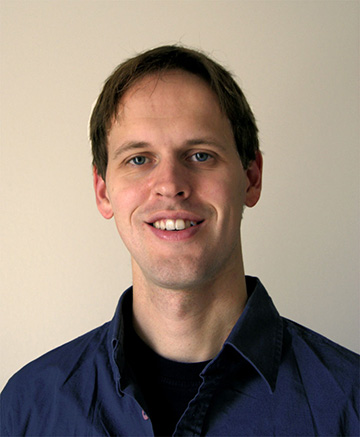
Stefan Witte. [Image: Courtesy of Vrije Universiteit Amsterdam]
Our May 2019 tutorial article offers a look at the basics of optical parametric chirped-pulse amplification (OPCPA), a technique that’s becoming increasingly important in the quest for few-cycle, very high-power optical pulses. To take a deeper dive into where OPCPA technology stands today, and some of the details that underlie the design of these systems, we talked with Stefan Witte, an expert on advanced lasers and optical technology with the Advanced Research Center for Nanolithography (ARCNL) and Vrije Universiteit Amsterdam, Netherlands, and the author of a review article on OPCPA technology.
OPN: At a very high level, OPCPA is a hybrid that combines chirped-pulse amplification (CPA) with optical parametric amplification (OPA). What is the rationale for doing that, and what sort of applications is it best for?
Stefan Witte: I would agree that at a high level, OPCPA combines CPA and OPA. But the reason for doing it is slightly different. In CPA, the rationale behind stretching the pulse is to make sure that your amplifier isn’t damaged—it’s really about reducing the peak power so that you can use the amplifier to get more energy into a pulse, and then getting the very high peak power at the end by shortening the amplified pulse.
In OPCPA, the reason for stretching isn’t really to prevent damage. The main rationale behind it is the ability to transfer the power from high-energy, long-pulse lasers to the short pulses that you can produce with femtosecond OPAs.
OPAs are really the world record holders in amplifying bandwidth—when it comes down to getting a few-cycle pulse directly from an amplifier, parametric amplifiers really beat any form of laser material that there is.
So essentially, the rationale for these systems in an application sense is the need for these very short, extremely high-power pulses.
Exactly. That’s the niche where OPCPA really comes in; that’s where it has its advantages. Higher energies can be provided by laser-based amplifier systems; shorter pulses can be provided by direct OPAs.
Another thing that makes OPCPA attractive in applications relates to average laser power. In many other systems, when you send 100-W average powers through, you start having to do all sorts of thermal management. That’s where OPAs are very beneficial—the parametric amplifier process itself doesn’t really produce any heating, so you can really scale up the amplification systems in terms of average power and, therefore, repetition rates. It makes your experiments go much faster in the end.
Could you talk a bit about the role of OPCPA in the European Extreme Light Infrastructure (ELI)?
Well, I’m not directly involved in ELI, but I’ve seen a lot of these systems as they’re being developed, seen a lot of conference talks, and I know the people involved. There are some very cool application perspectives at ELI, and some nice systems being developed.
What they’re trying to do is get systems in various parameter spaces in terms of wavelength, exact pulse durations, energies, repetition rates. But they all focus very much on being able to study the fastest processes out there. That, almost by definition, means trying to get the shortest pulses you can. OPCPA is indeed the way to go to get multiple millijoules, up to even joules, into a pulse on the order of 10 fs.
ELI has a very fascinating array of OPCPAs coming along, where people produce 5-fs pulses with several millijoules of energy up to a joule in tens of fs, with slightly different applications in mind. Going from really the high-energy particle physics to ultrafast spectroscopy, but also extreme nonlinear effects like high-harmonic generation at high fluxes.
What would you say, in this area of OPCPA, just looking at maybe the past five years, have been the significant technical developments?
I think one of the most significant technical developments is really the rise of the long-wavelength systems.
The nice things about OPAs is that they’re not really bound by the energy-level scheme that you have in a laser system or a laser amplifier—which limits you, for instance, to the 800-nm band of Ti:sapphire. If you can get phase matching going in a crystal, then you can build a parametric amplifier there. Essentially, any crystal that has a nonlinear response and is transparent at a given wavelength gives you a chance of building an OPCPA system there.
And with that idea in mind, people have built parametric amplifiers at 3-to-4-micron wavelengths, 2 microns, 1.5, whatever. Pretty much anywhere from the deep UV to the far infrared, it’s possible to build extreme-peak-power, short-pulse amplifiers that work.
And that’s something that’s really been exploited well in the past few years, I would say. There are a couple of systems around the world that really push that—you see a lot of high-average-power, 3-to-4 micron systems being produced, for atomic physics and for high-harmonic generation. I think that’s a very interesting development.
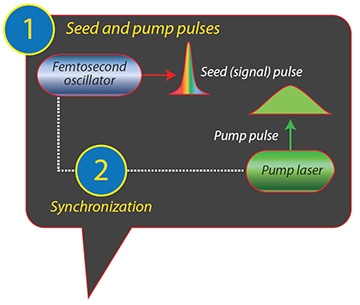
[Image: Art by Phil Saunders]
In our tutorial article, we look at the basic process of how OPCPA works. Let’s talk about a few of the details for a moment—starting with the creation of the “seed pulse,” the short, low-energy pulse that’s the thing that’s ultimately amplified. What are some of the design considerations there?
Essentially, the seed pulse determines the ultimate output, in terms of pulse duration, that your system can have. In OPCPA, no additional frequencies are being generated, so the Fourier transform limit of the input pulse is the optimum limit of what you can get on the output. So ideally, you start with the most broadband oscillator-derived pulse that you can find.
So if you have, say, Ti:sapphire-based systems—as we’ve used in the past in our lab, and still do—you try to get a 5-fs oscillator or so. With oscillators you can actually get there—you can get to few-cycle pulses.
Obviously that’s a bit harder in the regions that I mentioned before, like the mid-IR, where you don’t really have broadband lasers. In those areas, one way to work is to get, for instance, a medium- to short-pulse laser—something on the order of 100 fs to a picosecond—and to send that into a plate of crystalline material such as sapphire or quartz, where you get self-focusing or self-broadening of the spectrum—self-phase modulation that broadens the spectrum upon propagation, thereby increasing the frequency content of the pulse.
So in that way you can get a spectrum or a pulse with a very broad bandwidth in a part of the spectrum where your laser originally doesn’t emit, but still with the properties that allow you to compress it to a few-cycle pulse. And that’s a great starting point for amplifying further in an OPCPA.
And once you’ve generated that seed pulse, you need to temporally stretch it—the CPA part of the system. How is the pulse actually stretched? We hear about dispersive elements such as pairs of gratings versus fiber. What are the state-of-the-art technologies now for stretching the pulse?
To some extent, that’s the hardest part of few-cycle pulse amplification—because the broader the spectrum, the shorter the pulse. So ideally you want to keep the broadest bandwidth you can manage in your system. But that means that you have to consider dispersion to a very high level.
Now, typically dispersion is looked at in terms of group-velocity dispersion—second-order dispersion—and then higher-order terms like third-, fourth-, fifth-order dispersion. Mathematically, you use a Taylor expansion of the dispersion to describe this. And you can say the broader the bandwidth, the more of these higher-order terms you need to include.
Grating pairs are one method of doing the stretching. If you take two grating pairs, one in a stretcher configuration with a telescope in between, and the other just as a pair of parallel gratings, you can match them perfectly up to this second order—and, in principle, to the higher orders as well. But in practice, that's complicated to do using only gratings.
So if you go below 100 fs, you need to take care of that. And if you go toward 10 fs, then the fourth and fifth orders become even more important. You really need to start tailoring the spectrum accurately. You can do that with grating pairs, but you have to be very careful about the angles you set, and the exact geometries that you use.
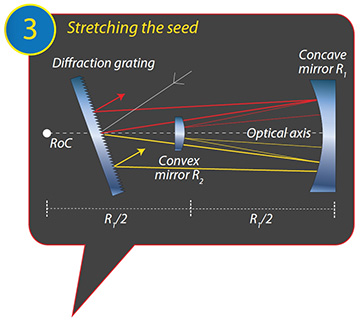
[Image: Art by Phil Saunders]
Are other approaches also being used?
Yes, there are other tricks. For example, you can have optical components like prisms and prism pairs. If you start mixing these components, you can do all sorts of tailoring of these higher-order dispersions. People have come up with “grisms,” for example—prisms with gratings etched into the side. There are also chirped mirrors that have special dielectric coatings on mirrors to introduce a controlled amount of dispersion on a pulse upon reflection. And you can really design those mirrors to give you the tailor-made dispersion that you want.
Except that one mirror doesn’t give you a lot of dispersion. So you’re either doing very limited stretching and compression, or you’re using many, many of these mirror reflections, which also ends up being lossy.
So I don’t think that the “magic” device has really been found yet for stretching these very short pulses. These techniques are either lossy, or are limited in the bandwidth they can handle, or are very elaborate to set up. But you see a lot of different schemes out there, and to some extent they all work. The common philosophy is trying to get the phase of your pulses controlled over the largest bandwidth that you can manage for this purpose.
Let’s look now at the pump pulse—which, in OPCPA is the broader-time-width pulse that carries the energy that’s transferred to the seed pulse during the amplification. How is that generated, and what are the considerations there?
You could say that one philosophy behind OPCPA is to transfer all of the technical problems that you have to the pump laser. The nice thing about OPCPAs is that they have enormous gains over very broad bandwidth. So in principle you can get all of the amplification you need from only a few crystals with a length of several millimeters each. Meanwhile, you have a very delicate, ultrashort laser seed pulse that goes through a stretcher, an amplifier and a compressor, and you keep all of those as small and compact as possible, and you want to do as little as possible with that.
So one philosophy is to try and limit the amount of stretching that you need—because the less stretching you do, the less compression you need at the end. If you make the pulse durations smaller, it stays a lot easier to control. But that then means that the pump pulse also needs to be as short as you can reasonably manage to be able to get an efficient OPA.
Because in the end, the pump pulse should be no more than a few times longer than the stretched seed pulse. That’s essentially why you need the stretching—to get the two pulses in the same order of magnitude in time, so that you get efficient transfer of energy from the pump pulse to the seed pulse. The shorter the pump pulse, the better from that perspective. If you can keep the pump pulse as short as you can reasonably manage, you end up with a much more controllable system.
So you see a lot of development of pump lasers for OPCPA that go into the few-tens-of-picosecond range. And picosecond laser technology is still something tricky. That said, a lot of that technology has been developed in the last 10 or 20 years—a lot of Nd:YAG and Nd:vanadate lasers that can really get pulse durations of a few tens of picoseconds, as well as, nowadays, a lot of ytterbium-based technology that really can get you to few-picosecond durations for the pump pulse. The pump lasers that are starting to be seen at ELI can produce extreme average powers on the hundreds of watts to few-kilowatts level, even in picosecond pulses.
And then there’s also the issue of synchronizing the pump with the seed pulse.
Yes—the big trick is to synchronize the pump and the seed pulse, because they need to arrive at the amplifier at exactly the same time for the energy transfer between the pump and the seed pulse to take place.
There are two approaches for synchronization—optical and electronic. The electronic techniques, which we use in our lab, are nice because you can say, OK, I take two lasers, I choose the wavelengths, etc., and I make sure that I keep the oscillators that the system starts with perfectly synchronized through a feedback loop. You need to get this synchronization down to the picosecond level—so that means some very high-speed, high-precision electronics and fast feedback loops. But it’s still not rocket science—it’s definitely do-able if you have some electronics infrastructure in house.
The alternative, optical synchronization, is very elegant. Here, both pulses, signal (or seed) and pump, are derived from the same laser. So intrinsically, the timing jitter between the two is zero. There, the problem is, how do you get the wavelengths for the pump and the signal out of this one laser? You need some sort of nonlinear conversion step to get to that—typically, people take the pump laser, split off a little bit of light, and go through some nonlinear process to produce a signal pulse with the wavelength and bandwidth they need.
All of that can be done, but getting the pulses out that you want for signal and pump is a challenge, sometimes requiring elaborate schemes with multiple nonlinear conversion steps and tricks to get both the pump and the signal at just the properties that you want. But there are solutions out there and it works very well.
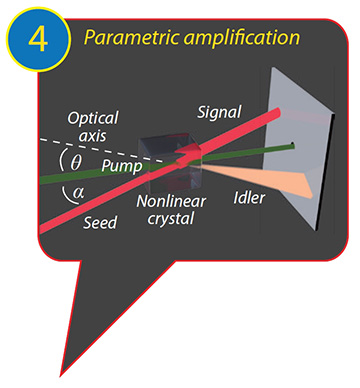
[Image: Art by Phil Saunders]
Now onto the actual amplification of the pulse—the OPA step. Here, you see two different kinds of beam geometries, “non-collinear” and “collinear.” Why?
The idea of doing a non-collinear system, where the seed and the pump beam come into the OPA crystal at slightly different angles, has to do with phase matching. Changing the non-collinear angle gives you matching of the group velocity at different wavelengths.
So instead of doing just phase matching or phase-velocity matching, you’re also doing group matching—you match phase velocities and group velocities. And that means you can have two pulses travel through a crystal over more distance, while staying aligned both in phase and in time.
The effect of that is that you can more effectively amplify very short pulses. In the frequency domain, it’s the same as saying that your amplification bandwidth goes up. And that explains the popularity of these non-collinear geometries.
One thing that’s happening lately, though, is that the other, collinear geometry is coming back. The idea there is that OPA gives you two output beams—an amplified signal pulse, and also an idler beam. The idler frequency is the difference frequency between the pump pulse and the signal pulse—and if the pump and signal are fairly close, the idler can be at very low frequencies and long wavelengths.
So in a system like this, the idler beam can be not just something that carries excess energy away, but actually as a useful output for getting amplified pulses at longer wavelengths like 3 and 4 microns. And a collinear geometry lets you use this idler beam more effectively for that purpose than a non-collinear geometry.
What about the actual crystals used for the OPA—we often see beta-barium borate (BBO) crystals in these systems. Is that pretty much the standard?
BBO is indeed the main one when it comes to the wavelength range from almost 200 nm to around a micron—the near-UV, visible, and near-infrared; that’s where BBO is a very nice material to work with.
If you want to go further into the infrared, BBO stops being so useful, because it’s not transparent above 2.4 to 2.5 microns. Then people typically move to crystals like lithium niobate, or KTP, or KTA—crystals that are also, like BBO, very well developed.
In the end, what you need is a nice nonlinear material that’s very transparent at the right wavelengths, and in which you can do good phase matching. And, of course, at these high powers, you need something with very high optical quality. Because if it has any disturbances or inclusions or impurities, it will easily be damaged by the intense pump pulses.
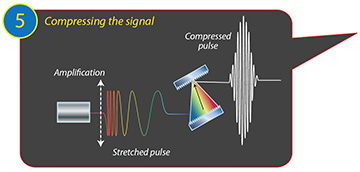
[Image: Art by Phil Saunders]
OK—the OPA step takes the stretched seed pulse, and transfers energy from the pump pulse. The final step is re-compressing the amplified seed or signal pulse, to get to those extremely high peak powers. I’m assuming that some of the considerations you mentioned earlier, regarding the stretching these very short broadband pulses and the importance of high-order dispersion terms, apply to compression as well?
Yes. You typically design the stretcher and compressor together. You look at the whole system and say, How much stretching do I need, and you make sure that the stretcher and compressor are matched to the point where you can really make sure that you get those short pulses. Typically it’s a joint thing. You don’t first design a stretcher and only then start to think about the compressor—you really need to do this hand in hand.
Selected OPCPA references
A. Dubietis et al. “Powerful femtosecond pulse generation by chirped and stretched pulse parametric amplification in BBO crystal,” Opt. Commun. 88, 437 (1992).
I.N. Ross et al. “The prospects for ultrashort pulse duration and ultrahigh intensity using optical parametric chirped pulse amplifiers,” Opt. Commun. 144, 125 (1997).
T. Wilhelm et al. “Sub-20-fs pulses tunable across the visible from a blue-pumped single-pass noncollinear parametric converter,” Opt. Lett. 22, 1494 (1997).
S. Witte and K.S.E. Eikema. “Ultrafast optical parametric chirped-pulse amplification,” IEEE J. Sel. Top. Quant. Electron. 18, 296 (2011).
Q. Zhang et al. “Dual-chirped optical parametric amplification for generating few hundred mJ infrared pulses,” Opt. Express 19, 7190 (2011).
C.V. Filip. “Computers at work on ultrafast laser design,” Opt. Photon. News 23(5), 24 (2012).
H. Fattahi et al. “Third-generation femtosecond technology,” Optica 1, 45 (2014).
C. Manzoni and G. Cerullo. “Design criteria for ultrafast optical parametric amplifiers,” J. Opt. 18, 103501 (2016).
A.G. Ciriolo et al. “Optical parametric amplification techniques for the generation of high-energy few-optical-cycles IR pulses for strong field applications,” Appl. Sci. 7, 265 (2017).
X. Liang et al. “Design and experimental demonstration of a high conversion efficiency OPCPA pre-amplifier for petawatt laser facility,” High-Power Laser Sci. Eng. 6, E58 (2018).
R. Dabu. “High-power, high-intensity contrast hybrid femtosecond laser systems,” in M. Harooni, ed., High Power Laser Systems (IntechOpen, 2018).
